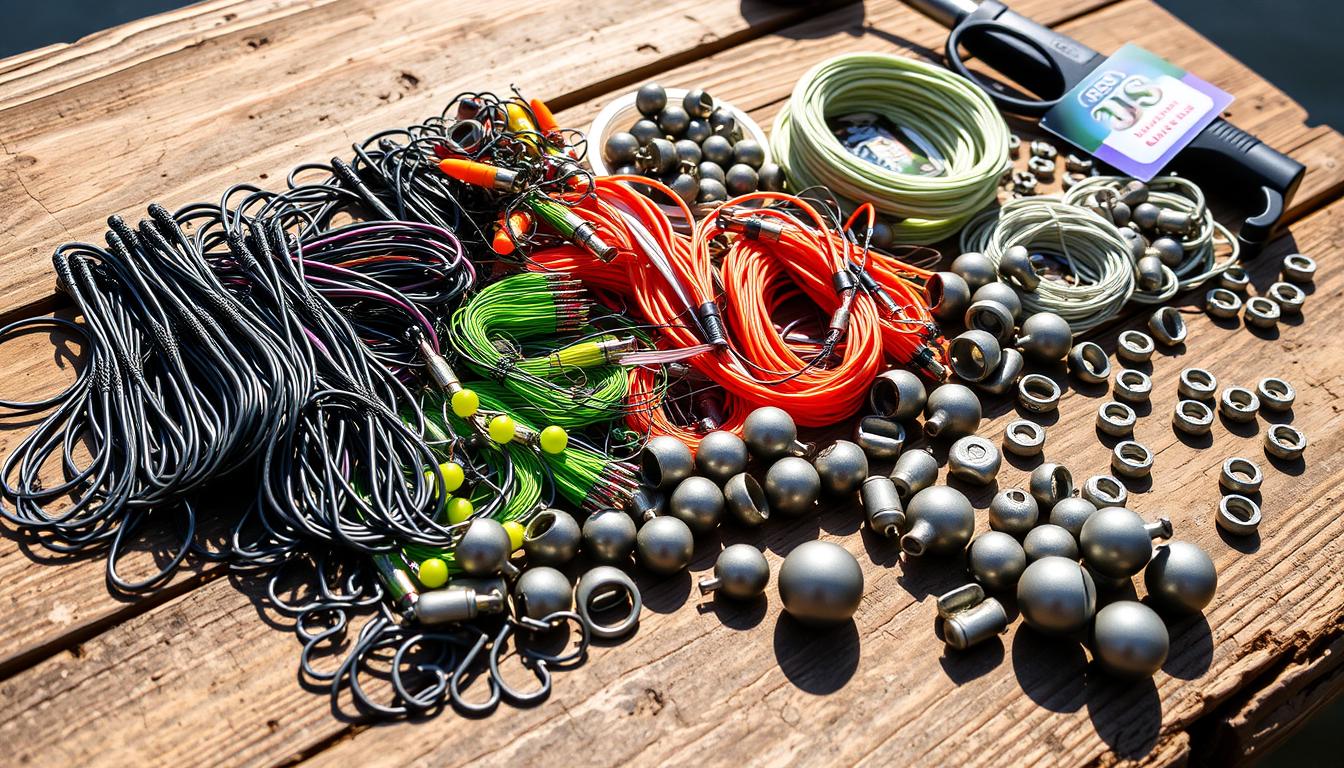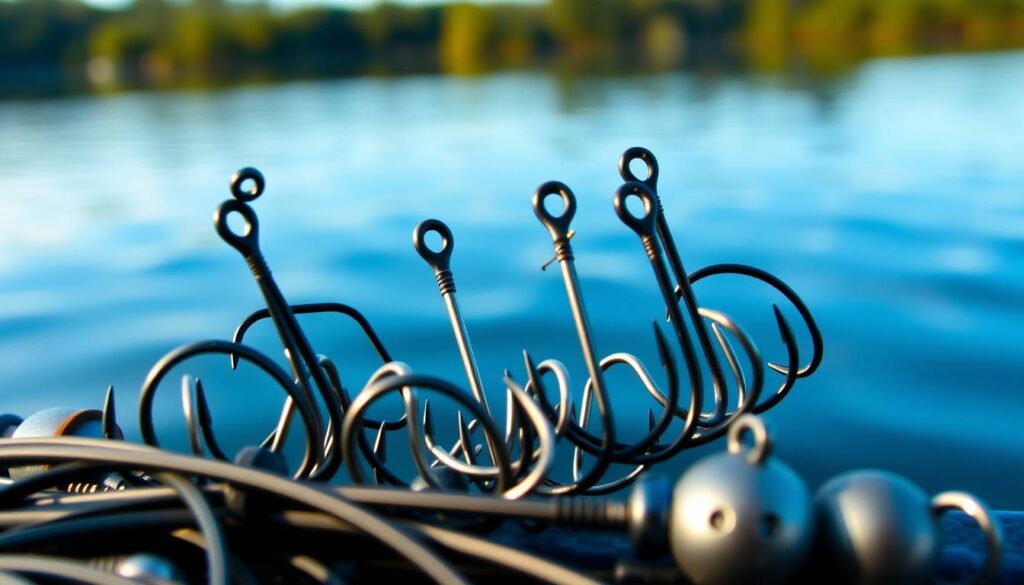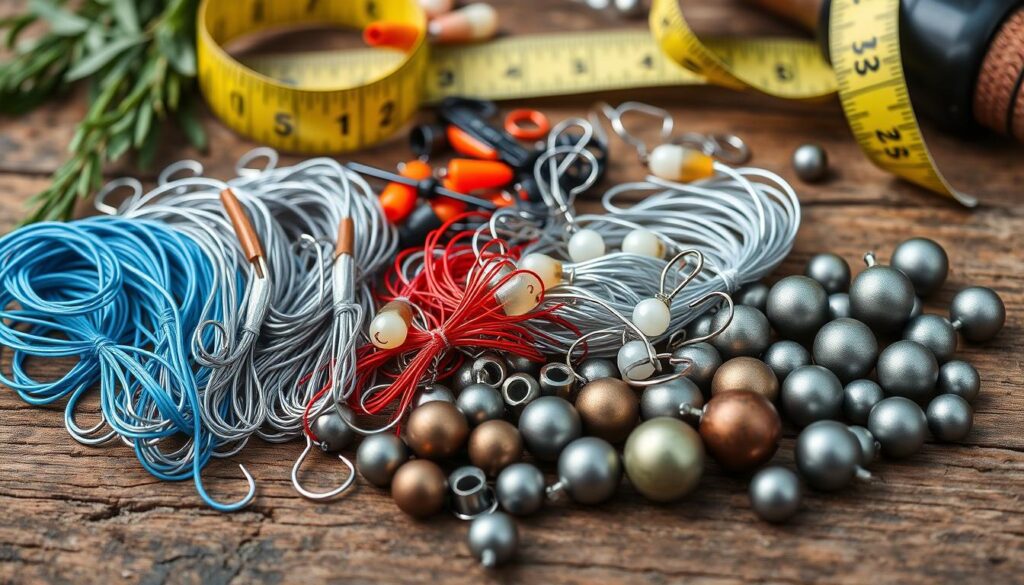Physical Address
304 North Cardinal St.
Dorchester Center, MA 02124
Physical Address
304 North Cardinal St.
Dorchester Center, MA 02124

Anglers aiming to catch trophy bass know the right gear is key. This guide will cover the best hooks, lines, and sinkers for bass fishing. We’ll help you pick the perfect tackle to catch those tough bass.
Fishing hooks, lines, and sinkers are key parts of an angler’s gear. They work together to help catch bass. Each part is important for a successful fishing trip.
The hook is the most important part of fishing. The right hook can make all the difference in catching fish. Gamakatsu, Owner, Eagle Claw, and Mustad are top brands for bass fishing hooks.
There are many sizes of hooks, from tiny ones for trout to big ones for sharks. Choosing the right size is crucial.
The line is the core of your setup. It affects how far you can cast and how sensitive your line is. For beginners, a 15 lb. Berkeley Big Game green monofilament line is a good choice.
Other popular mono lines include P Lines 12 lb. moss green CXX and Trilene XT green 14 lb. lines. Braided lines are great for fishing frogs or flipping heavy cover. Fluorocarbon lines are best for light line and clear water.
Together, hooks, lines, and sinkers make a great bass fishing system. They help anglers present their lures well and catch more fish.
| Fishing Line Type | Recommended Use | Advantages |
|---|---|---|
| Monofilament (15 lb. Berkeley Big Game green) | Versatile choice for bass fishing, especially for beginners | Durable, cost-effective, and suitable for a range of fishing applications |
| Braided Line | Fishing frogs or flipping heavy cover | Increased sensitivity, strength, and abrasion resistance |
| Fluorocarbon Line | Light line and clear water scenarios | Near-invisible in the water, superior abrasion resistance |
“Hooks, lines, and sinkers are the fundamental building blocks of an angler’s tackle. They work together to create an effective system for presenting lures and baits to targeted fish.”
Choosing the right hooks is key for bass fishing. Anglers must pick the hook design and size that fits their fishing style. This ensures they can effectively present their lures and hook bass.
Straight shank hooks work well for Texas rigging soft plastic worms. Their design keeps the bait weedless and the hook point hidden. This allows the lure to move through cover naturally, perfect for fishing in thick vegetation.
Offset worm hooks are great for soft plastic baits like worms and swimbaits. They hold the bait securely but still let it swim naturally. These hooks are reliable for catching big bass.
EWG (Extra-Wide Gap) hooks are best for big swimbaits and creature baits. Their wide gap and strong point ensure they hook bass well. These hooks are crucial for catching large bass.
| Hook Type | Best For | Key Advantage |
|---|---|---|
| Straight Shank | Texas Rigs | Weedless presentation |
| Offset Worm | Rigging Plastics | Secure hold, natural action |
| EWG | Large Swimbaits/Creature Baits | Solid hook penetration |
Knowing how to use these specialized hooks can help anglers catch more bass. It’s all about choosing the right tackle for the job.

Anglers have two main line options for bass fishing: monofilament and braided. Each line has its own benefits for different fishing styles and conditions.
Monofilament has been a favorite for over 50 years. It stretches, which helps when fighting big bass. It’s also soft and can handle abrasions well, making it great for light tests under 10 pounds with spinning gear.
Braided fishing line has become more popular lately. It’s tough, thin, and casts well. It has little stretch, making it perfect for deep fishing.
| Feature | Monofilament | Braided |
|---|---|---|
| Stretch | Up to 25% stretch | Virtually no stretch |
| Sensitivity | Moderate | Excellent |
| Abrasion Resistance | Moderate | High |
| Casting | Good for light lures | Superior for long casts |
| Visibility | More visible in water | Less visible in water |
Choosing the best bass fishing line depends on your fishing style and conditions. Sam Lee and Steve Pennaz like monofilament for many reasons. Rich Zaleski and Bruce Holt prefer braided fishing line for its sensitivity and distance.
“Braid has virtually no stretch, making it extremely sensitive and ideal for deep water fishing.”
The choice between monofilament and braided fishing line is personal. Knowing each line’s strengths helps anglers choose the right one for their fishing needs.
For bass anglers, the right hooks, lines, and sinkers are key. They form the core of a good fishing setup. This setup helps catch largemouth and smallmouth bass in many places and conditions.
Choosing the right hooks, lines, and sinkers is key to catching big bass. Each part of this setup is important. They help connect the angler to the bass and ensure a good hook set.
| Tackle Component | Top Performers | Market Share |
|---|---|---|
| Fishing Hooks | Brand A, Brand B, Brand C | 25%, 20%, 18% |
| Fishing Lines | Fluorocarbon, Monofilament, Braided | 40%, 30%, 25% |
| Fishing Sinkers | 1/4 oz – 1/2 oz, 3/4 oz, 1 oz | 45%, 30%, 20% |
Anglers who stick to their favorite tackle can face any fishing challenge. They can fish in thick cover or open water. By knowing how to use hooks, lines, and sinkers, anglers can catch their biggest bass yet.
“The combination of the right hooks, lines, and sinkers is essential for successful bass fishing. Anglers must carefully select each component to create an effective and versatile fishing system.”

Whether you’re a pro or just enjoy fishing on weekends, knowing about hooks, lines, and sinkers is crucial. Adding these to your tackle can help you catch trophy bass. It’s a step towards becoming a better angler.
Fishing sinkers are key in bass fishing. They help anglers control how deep and how their lures move. Knowing the different sinkers and when to use them is crucial for catching bass.
Slip sinkers are great for Texas and Carolina rigs. They let the weight slide along the line, giving a natural action. This makes the lure move like prey, which can get bass to bite.
Tie-on weights are used in drop shot and finesse rigs. They connect directly to the tackle, making it more sensitive. This is good for fishing in tight spots or when bass are picky.
| Sinker Type | Fishing Technique | Key Benefits |
|---|---|---|
| Slip Sinkers | Texas Rig, Carolina Rig | Natural, bottom-hugging action |
| Tie-on Weights | Drop Shot, Finesse Rigs | Increased sensitivity, precise bait positioning |
Knowing the different sinkers and their uses can improve your bass fishing. It can help you catch bigger fish.
“Mastering the art of using the right sinkers is essential for any serious bass angler. The right choice can make all the difference in your presentation and ultimately, your success on the water.”
Choosing the right bass fishing tackle can be tough. Luckily, there are top brands known for their quality hooks, lines, and sinkers. These brands help you catch more largemouth bass. Some of the best and most trusted names include:
By choosing products from these respected brands, you can be confident that you have the necessary tools to catch trophy bass and enjoy a successful day on the water.
Getting your fishing tackle for bass rigged right is key to catching fish. The Texas rig and the Carolina rig are two top picks for different fishing spots. They let anglers fish naturally and cover lots of water.
The Texas rig is great for soft plastic baits in thick cover. It hides the hook, so you snag less. This makes it perfect for targeting largemouth bass in busy spots.
The Carolina rig is perfect for fishing big areas. It reaches deep and fishes naturally, helping you catch trophy bass. It’s ideal for open water searches.
Learning these rigs can make you a better bass fisherman. It lets you choose the right tackle for any fishing spot, leading to more success.
As avid anglers, we know that the key to mastering bass fishing is not just in the technique, but also in the proper maintenance and care of our essential fishing tackle. From hooks and lines to sinkers and lures, taking the time to keep our gear in top condition can significantly improve our overall fishing success.
One of the most critical aspects of maintaining your fishing tackle is regularly inspecting your hooks for any signs of wear or damage. Fishing tackle for bass needs to be in pristine condition to ensure a secure and reliable hook-set. Gently running your fingers along the point and bend of the hook can help identify any dullness or bends that may affect its performance.
Similarly, it’s essential to keep your fishing lines in good shape. Bass fishing gear essentials include having well-maintained lines that are free from fraying, kinks, or unnecessary tangles. Regularly cleaning and re-spooling your lines can extend their lifespan and optimize their casting and hook-setting abilities.
By taking the time to properly maintain and care for your fishing tackle, you can extend the lifespan of your gear and have confidence in its performance, ultimately enhancing your overall bass fishing experience.
| Maintenance Tip | Benefit |
|---|---|
| Regularly inspect and replace worn hooks | Ensures secure hook-sets and reliable catches |
| Clean and re-spool fishing lines | Improves casting distance and sensitivity |
| Store gear in a cool, dry place | Prevents corrosion and extends lifespan |
| Organize tackle for easy access | Streamlines the fishing experience |
“Taking care of your fishing tackle is just as important as mastering the techniques. It’s the foundation for a successful and enjoyable fishing trip.”
Choosing the right hooks, lines, and sinkers is key to catching bass. Knowing how each piece works helps anglers set up the best gear for their fishing style. This is true whether you’re after largemouth or smallmouth bass.
By getting good at using hooks, lines, and sinkers, you can catch bigger bass. This guide has shown you how to pick the best hook for your bass lures and rigs. It also helps you choose the right fishing line for your bass fishing techniques.
With the right bass fishing gear essentials, you can catch more largemouth bass and trophy bass. Follow the professional bass angling tips in this article. You’ll get better at mastering bass fishing and have more fun on the water.